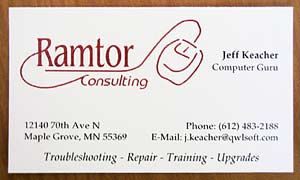Going for it
About six and a half years ago, a man named David Roux came to speak at Rose-Hulman. I was an undergrad at the time, in my junior year, and I was probably more concerned with an upcoming snowboarding trip to Steamboat Springs than a lecture from some unfamiliar old guy. However, his main point sunk in: Don’t be a worker bee. Start. Lead. Explore. Create. Be an entrepreneur.
As of today, I am officially abandoning my job hunt. I have found what I was looking for; I had it all along. The problem was a lack of complete commitment.
I have been doing entrepreneurial things since I was a child. Mowing lawns at first, later doing IT consulting and computer repair. While in undergrad, I dabbled in the world of web development by building Bonneville Club, which served as an invaluable lab for me to learn about server administration, community building, people management, and revenue generation. Later, I experienced the thrill of being web-famous with a couple of popular blog posts and millions of visitors to my webcomic.

The business card from my IT consulting "company" during high school, a decade ago.
I valued my time at Medtronic after undergrad. I had wonderful co-workers, a company that treated its employees very well, and a salary higher than many see in their lifetimes. But I wasn’t satisfied.
“I realize this seems odd advice. If they make your life so good that you don’t want to leave, why not work there? Because, in effect, you’re probably getting a local maximum. You need a certain activation energy to start a startup. So an employer who’s fairly pleasant to work for can lull you into staying indefinitely, even if it would be a net win for you to leave.”
When I went to grad school, I chose to study entrepreneurship in the Management Science and Engineering program. I took courses on starting companies. I attended lectures by famous entrepreneurs. I talked with Silicon Valley venture capitalists and CEOs. I idolized my successful-entrepreneur professors. I watched my friends start and build businesses.
There was, I believe, a bit of jealousy. If my friends could do it, why not me? I mean, I was smart, too. Why couldn’t I experience the dizzying highs and crushing lows? Why couldn’t I build amazing products? Why couldn’t I achieve financial freedom? Why not?
I have come to realize that there were two things holding me back: fear and social expectations. For a time I used money or a lack of ideas as excuses, but a detailed examination of business case studies shows that deficiencies in those areas rarely represented insurmountable obstacles. No, the fear of the unknown kept me locked in place, and that kept me in line with society. Why give up a good job at a solid company in the pursuit of a crazy dream? What’s more, society tends to fear change and uncertainty and ostracize those who dare challenge the status quo. To many, the thought of venturing off on one’s own is pure madness.
But without change there cannot be progress. Who will move the world if not me?
“If you want to do it, do it. Starting a startup is not the great mystery it seems from outside. It’s not something you have to know about ‘business’ to do. Build something users love, and spend less than you make. How hard is that?”
— Paul Graham
In some ways, the economic collapse was the best thing that could have happened for me. It made my job search difficult to the point of impossibility. In hindsight, I don’t know why I was looking for a job at an established company instead of venturing out on my own. Clearly, my heart wasn’t in the hunt. The challenge was worsened by my desire to switch into a more business-oriented role and away from my technical roots. I had good discussions with a few companies and interviews with some others, but they seemed loath to help me make that transition. A few went as far as to offer me technical roles developing software, but such capitulation would be, in my mind, career suicide. Another job as a software engineer for somebody else would nullify my entire graduate education and permanently cement me in my pigeonhole. I would rather abandon high-tech entirely than write software in a cube for somebody else. Oh, and I don’t think I’m a very good programmer.
“You‘ve got all these cops thinking you‘re a lawyer. And you got all these lawyers thinking you‘re some kind of cop. You‘ve got everybody fooled, don’t you?“
— from the film “Michael Clayton”
Writing software for myself is entirely different. Despite my not being particularly good at it, developing software for my own ends is deeply satisfying. I love the act of creation. I love the instant gratification. I love the communion between me and my machine.
Thus, my startup is a software startup. Of my many interests — hockey, photography, baking, etc. — software is the one most amenable to company-building. Who cares if the prototype code is crap? If it works well enough to get me to the next stage, where I might be able to hire a competent coder to replace my hacker self, then the mission has been accomplished.

Nesota LLC world headquarters
My intent is to give this my all. When I turn 30 in three years, I want to be either rich or penniless. The outcome doesn’t matter so much to me as long as it’s not the mushy middle; that would be indicative of a failure. I want to know that I gave it my full effort. I don’t want to half-ass it and spend the next decade wondering what could have been.
I’m not rich. I’m not famous. I have limited capital, a car with 204k miles on it, and a two-year-old computer.
But I have ambition. I’m going for it.
(cross-posted at Northstartup)


Recent Comments